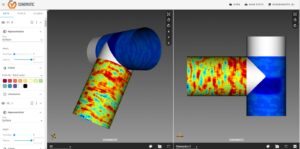Transforming how integrity management is performed using 3D visualisation
Project Summary
Industry context/Challenge:
Integrity management of pressure equipment commonly involves gathering large volumes of component wall thickness data throughout the life of the plant. Current methods of relating wall thickness data to a specific physical location on a plant is a manual and labour-intensive process made via standalone drawings and diagrams.
Project overview:
This project with Sonomatic Ltd set out to transform the way integrity management is performed and reported providing significant efficiency savings. In addition, providing asset managers with improved confidence in the integrity status of their plant to enable more accurate risk-based assessments to be made. The project developed a proof-of-concept demonstration of a system that links inspection and historical data to 3D models to facilitate fitness for service assessments. It used pipework from Marathon’s Brae Alpha platform as a basis to demonstrate a system for linking inspection data to a 3D model to provide a visual representation of the results.
The model was created using isometric drawings provided by Marathon to create visualisation of the inspection and corrosion data for the selected pipework system.
Industry value:
The ability to visualise the physical location of equipment allows for the true likelihood and consequence of failure to be understood in relation to its location and geometry to the rest of the plant. More accuracy and higher confidence in the assessments and the overall risk profile of the plant resulted in optimised budgets and a reduction in future inspections by 10%. For an asset with a typical annual inspection budget of £1M this equates to a £100k saving per year.
Lessons learned:
Feedback from Marathon and the project team for commercialisation and widespread adoption:
- Linking of corrosion mapping data can be simplified by following specific procedures for data collection and file-naming to facilitate model generation.
- It is likely operators would continue to use a more traditional RBI (Risk Based Inspection) database. A form of linking to that database would be necessary to maximise the value of the 3D model approach.
- There are limitations to showing the corrosion mapping data when zoomed out on a large piping system. At that level one can get an overview of the areas covered but it is not possible to resolve the local details. Further work is needed on defining how to transition through different levels of detail to be shown on the 3D models.
- The demonstration has shown that the system models can be built efficiently. However, some training of end users would be necessary to facilitate application by integrity engineers in practice.
- There are a growing number of software applications addressing similar requirements to those covered in this project. Standardisation at an industry level will be necessary to ensure wider application and that the benefits of these approaches are fully realised.

Let's work together
"Required" indicates required fields